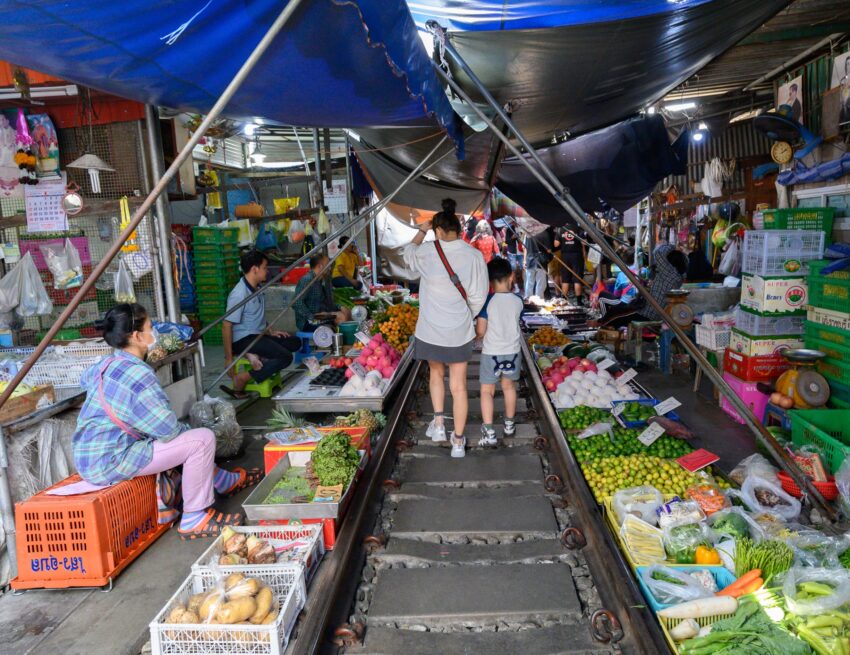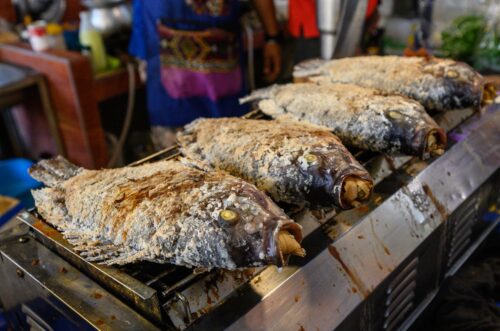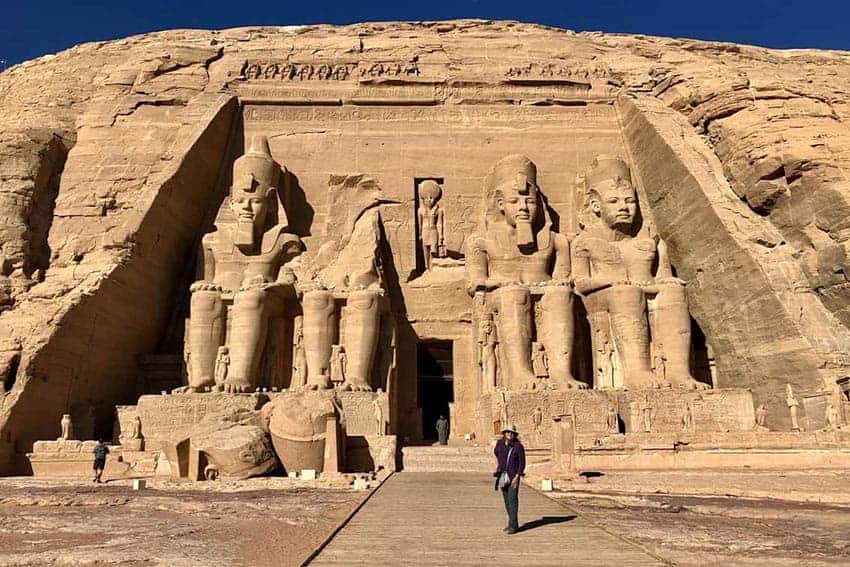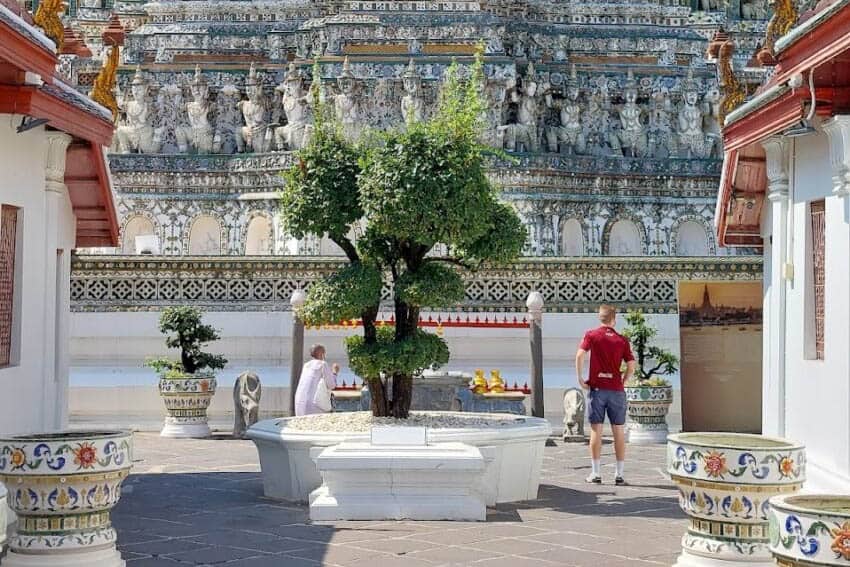
Adventuring into Bangkok’s Intriguing Markets
By Donnie Sexton
Senior Writer

I think of myself as an adventurous and daring traveler unless I’m trying to navigate a monster-sized city like Bangkok.
You can always Google tips on how to get around by taking public transportation, whether it’s local buses, subways, etc. Not me!
I don’t want to waste time or energy trying to figure out the cheapest way to get around and looking like a bewildered tourist, especially in Thailand where the language, written like curlicues, is challenging to decipher.
Temples, and more Temples
I prefer to hire a local guide and give that person my laundry list for the day. That’s precisely how I did Bangkok.
I’ve been to this popular Asian city three times.
My first visit focused on seeing the major attractions, which equated to a wealth of bedazzling temples.

Bangkok’s Grand Palace
I started with The Grand Palace, a sprawling complex that was home to the Thai monarchs until 1946.
It’s a maze of elaborate tilework, gold-plated columns and statues, and intricate buildings with endless spires and ornamental squiggles on the roofs.
It was mind-boggling to think of the labor involved in building this complex, which got underway in 1782.
| Seven Markets Not to Miss in the Philippines |
Inside the Grand Palace is Wat Phra Kaew, considered the most sacred temple in Thailand and home to the famous Emerald Buddha.
The long line to visit this temple was discouraging, and no photos were allowed, so I took a pass.
My next stop was Wat Pho, home of the largest reclining Buddha in Thailand.
The statue, covered in gold leaf, is 151 feet long, and in a word, impressive. Wat Pho was a mere 10-minute walk from the Grand Palace.

My favorite temple complex is Wat Arun, nicknamed the Temple of Dawn, and in my mind, an exquisite work of art.
The structures were covered with thousands of tiny pieces of seashells, colored glass, and Chinese porcelain, forming intricate patterns, borders, statues, and flowers.
A steep set of stairs lead to the top of the main tower, where the sweeping views of Bangkok and the Chao Phraya River were worth the climb.
There are more temples worthy of talking about, but my story is focused on my second visit to Bangkok, where I was keen on exploring and photographing local life as witnessed through the markets.
Damnoen Floating Market
Top of my list was the Damnoen Floating Market. Thai people, especially in rural areas, have traditionally used boats meandering through canals as a means of buying and selling food and necessities.
The Damnoen Market has become a tourist magnet, so I was determined to arrive at the crack of dawn before the crowds.
I hired Kally Kalinkoos, a private guide/driver listed on the Viator website. The Market is 60 miles from Bangkok and takes a bit longer than an hour to reach.
We arrived around 6 am to see the very first longboats laden with produce coming into the central canal.

The Damnoen Market quickly filled up with a flotilla of boats, manned mainly by women. They were laden with fruits, vegetables, souvenirs, straw hats, and clothing.
Some of the boats functioned as floating food stalls, where bowls of steaming noodles and other Thai delicacies were prepared on-site.
The boats were always on the move, jostling for prime positions and calling out to visitors for business.
Either side of the canals functioned as open-air markets, with more trinkets, crafts, and food stalls.
The noisy interaction smells, and a rainbow of colors was priceless in terms of being in the thick of Thai culture.
Kally and I came across a foot massage parlor, where we had a 45-minute treatment for one dollar, followed by a snack of mango sticky rice!

I highly recommend the trip to Damneon. Yes, it’s crowded with Bermuda short tourists, but sometimes you have to let that go and dive into the mix to get the best experience possible.
Amapawa Floating Market
Amapawa Market is a smaller version of the Damneon Market but much less hectic.
It’s about an hour’s drive from Bangkok, although it’s possible to reach the Market via a one-hour boat ride on the Mae Klong River.
There were significantly fewer boats, with most tied up along the sides of a wide canal and functioning as food stalls.
On either side of the canal, several shops were selling local handicrafts, along with cafes and coffee shops.
This Market is popular with the locals who come for the eats, especially the grilled seafood and boat noodles.
Maeklong Railway Market

The Maeklong Railway Market fell into my category of “I can’t believe my eyes.”
The original Maeklong Market opened in 1905. When a new train line was planned a few years later, stubborn vendors refused to move from their location.
Today, the Market and train coexist.
Fruits and vegetables are piled high next to the tracks, while several vendors use tables on wheels to display the meats and fish.
The train passes through the Market four times daily.
When the train whistle blows, the vendors quickly and efficiently roll back their tables and the awnings covering their goods, wait for the train to pass, then roll everything back out in a matter of minutes.

Most people walk on the tracks and move to the side as the train passes.
I couldn’t resist reaching out and touching the engine as it passed (just because I could).
Like the Damneon Market, it’s crowded by midday, but again, it’s an experience worth dealing with the crowds.
Khlong Toei Market

On my quest for local markets, I emailed a Bangkok photographer for ideas.
Without hesitation, he said I must visit the largest and most authentic market in Bangkok, the Khlong Toei Market.
He volunteered to take me there.
There was a covered section, where vendors were selling a bit of everything, including housewares, clothing, prepared food and produce.
Lining the streets were more vendors using awnings and large umbrellas to cover their heaps of raw meat, fish, chicken, and pork.
I discerned that no part of the animal goes to waste, including entrails, brains, pig’s feet, fish heads, and other unidentifiable body parts.
The smell and the visuals of all those animal parts made my stomach do a few somersaults.
I witnessed how Thais go about grocery shopping, which tends to be a daily occurrence as many lack refrigeration for storing food. What this Market lacked were tourists.
I stood out as a foreigner and felt the glare of several locals.
I have a deep appreciation now for my sparkly clean supermarket, where meat, poultry, and fish are carefully packaged!
Bangkok’s Flower Market, Pak Khlong Talat

As opposed to the stinky Khlong Toei Market, Bangkok’s flower market, was almost overpowering with fragrant smells.
The Market, open 24 hours per day, serves as a wholesale Market for local florists and is a source of fresh flowers for the many hotels and restaurants in Bangkok.
I found it intriguing to watch as the locals created artistic bouquets, often utilizing carefully folded leaves in the process.
Some vendors were busy stringing and selling phuang malai (flower garlands), often used as offerings in Buddhist temples.
This Market doesn’t see many foreigners, so those working the stalls were full of smiles and seemed appreciative of my visit.
Glimpse of Thai Life
For the curious traveler and especially for photographers, I highly recommend any of the markets I’ve listed for a glimpse into Thai life.

Hire a guide to preserve your sanity while negotiating this city of 8.3 million people.
You’ll be doing your part in supporting knowledgeable locals.
- Butte, Montana: Home to the Richest Hill on Earth - April 6, 2024
- Spain’s Extremadura: History and Famous Pigs - December 20, 2023
- Storm Chasing Across Tornado Alley - October 25, 2023




